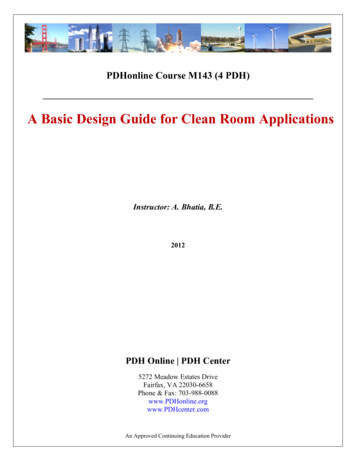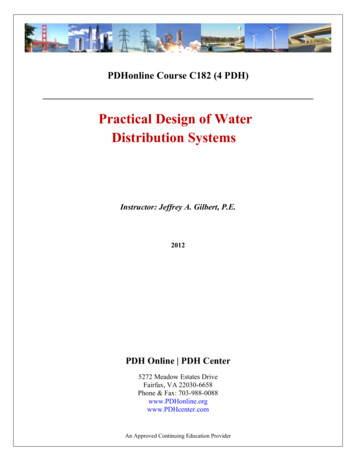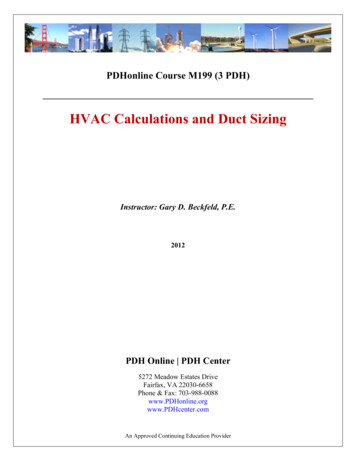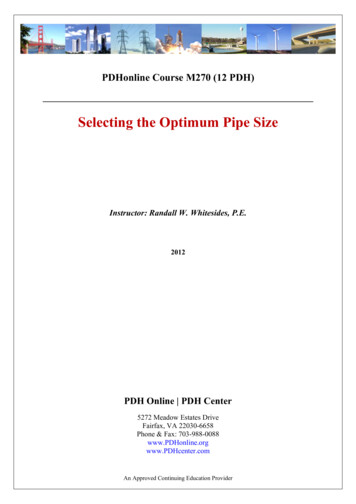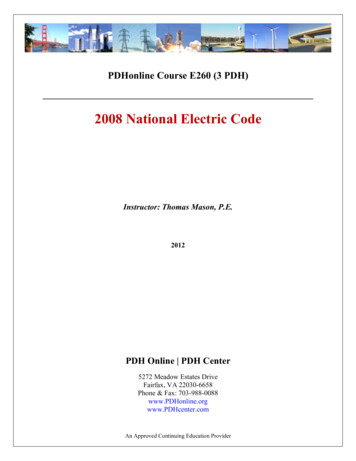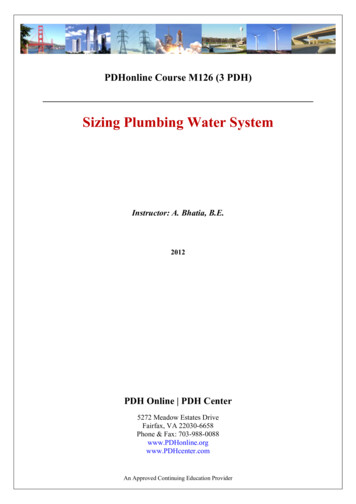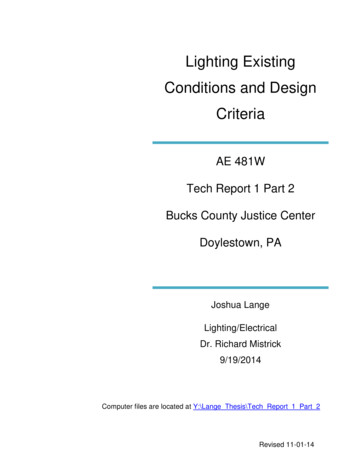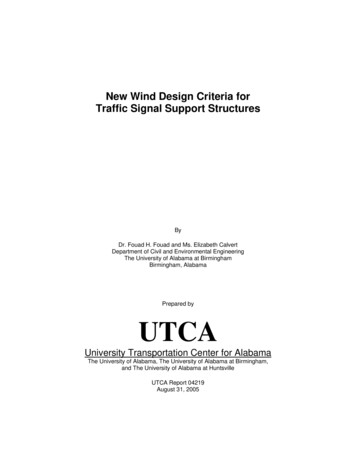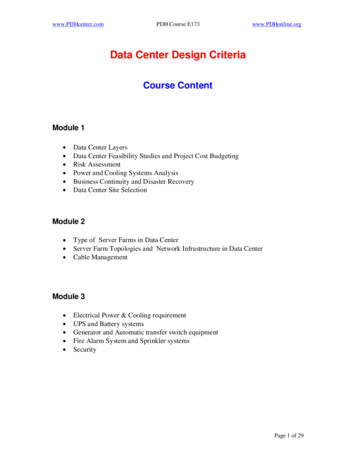
Transcription
www.PDHcenter.comPDH Course E173www.PDHonline.orgData Center Design CriteriaCourse ContentModule 1Data Center LayersData Center Feasibility Studies and Project Cost BudgetingRisk AssessmentPower and Cooling Systems AnalysisBusiness Continuity and Disaster RecoveryData Center Site SelectionModule 2Type of Server Farms in Data CenterServer Farm Topologies and Network Infrastructure in Data CenterCable ManagementModule 3Electrical Power & Cooling requirementUPS and Battery systemsGenerator and Automatic transfer switch equipmentFire Alarm System and Sprinkler systemsSecurityPage 1 of 29
www.PDHcenter.comPDH Course E173www.PDHonline.orgModule 1Data Center LayersThe data center design process starts by working with the management staff to determinebusiness’s data center project needs and combine this with the understanding of thetrends and migration strategies required in adapting to future changes. Finally aconceptual data center design is developed and from which construction budget and timelines are put together.Figure 1-1: Data Center LayersPage 2 of 29
www.PDHcenter.comPDH Course E173www.PDHonline.orgThe modern Data center has various components. Figure 1.1 above shows all thecomponents as different layers. All the layers will be discussed in detail in this course.As shown graphically in this figure, “Applications, Database & Content” layer is the corelayer which is the prime concern for corporation’s user’s point of view. But as we can seefrom the figure 1.1, for reliability and accessibility of this “core” layer there are severalother layers need to be designed properly for Data center to be ideal.Three important attributes of any good Data Center Design are scalability, flexibility andhigh availability.Scalability:The Data Center Design must support fast and seamless growth without majordisruptions.Flexibility:The Data Center Design must support new services without a major overhaul of itsinfrastructure.High Availability:The Data Center Design must minimize single point of failure and offer predictableuptime by incorporating concurrent maintainability and fault-tolerance against hardfailures.Data Center Feasibility Studies and Project Cost:Data center project feasibility and cost budgeting is accomplished by applying KeyDesign Criteria of the two main categories of the budget:The Information Technology Infrastructure & Services (IT):Each corporation has different Infrastructure in place depending upon the nature ofthe business. Spacing, Engineering and Security design depends a lot on primary useof the Data Center.Infrastructure can be mix of various manufacturers for the same type of equipment,for example, Data servers can be from manufactures like Sun, IBM, Dell or Compaq.This prompts for different Rack types and different power outlet requirement for eachtype of servers.It is important to know the migration schedule from IT department of existinghardware for Flexibility.Page 3 of 29
www.PDHcenter.comPDH Course E173www.PDHonline.orgSupport Infrastructure and Services (Facility):Location and size of the data center should be well coordinated with IT staff andfacility maintenance staff.Electrical and Air Conditioning: while selecting a location and space, Electrical andAir conditioning must be kept in mind. It should be feasible to add extra electrical andAir conditioning loads.Maintenance staff: dedicated and trained maintenance staff should be available 24x7to support data center issues.Risk Assessment:A comprehensive data center inspection is needed to assess the ability of the supportinfrastructure to provide continuous availability which include the following:An evaluation of the present load conditionA comparison to the capacity constraintsIdentification of critical deficienciesPotential downtime risksAn assessment of the concurrent maintenance capacity of the sitePower and Cooling Systems Analysis:A complete load profiling and reporting from simple spot-checking to week-long datashould be used to accomplish the following:An evaluation of the present load conditionA comparison to the capacity constraintsIdentification of critical deficienciesAn assessment of the concurrent maintenance capacity of the siteRedundant power supplies, 24 x7 backup facilities, multiple environment controlsystemsPage 4 of 29
www.PDHcenter.comPDH Course E173www.PDHonline.orgBusiness Continuity and Disaster Recovery:A detailed assessment must be made while designing a data center for the following:Identify Mission Critical Applications and ServersStaff availability in the event of DisasterRemote access to ApplicationsSite Selection:Data Center Site selection should be made based on all the above discussed factors.Page 5 of 29
www.PDHcenter.comPDH Course E173www.PDHonline.orgModule 2Types of Server Farms and Data CentersAs depicted in Figure 2-1, three distinct types of server farms exist:InternetExtranetIntranetFigure 2-1 Overview of Data center TopologyAll three types reside in a Data Center and often in the same Data Center facility, whichgenerally is referred to as the corporate Data Center or enterprise Data Center. If thesole purpose of the Data Center is to support Internet-facing applications and serverfarms, the Data Center is referred to as an Internet Data Center.Server farms are at the heart of the Data Center. In fact, Data Centers are built to supportat least one type of server farm. Although different types of server farms share manyarchitectural requirements, their objectives differ. Thus, the particular set of Data Centerrequirements depends on which type of server farm must be supported. Each type ofserver farm has a distinct set of infrastructure, security, and management requirementsthat must be addressed in the design of the server farm. Although each server farm designPage 6 of 29
www.PDHcenter.comPDH Course E173www.PDHonline.organd its specific topology might be different, the design guidelines apply equally to themall. The following sections introduce server farms.Internet Server FarmsAs their name indicates, Internet server farms face the Internet. This implies that usersaccessing the server farms primarily are located somewhere on the Internet and use theInternet to reach the server farm. Internet server farms are then available to the Internetcommunity at large and support business-to-consumer services. Typically, internal usersalso have access to the Internet server farms. The server farm services and their users relyon the use of web interfaces and web browsers, which makes them pervasive on Internetenvironments.Two distinct types of Internet server farms exist. The dedicated Internet server farm,shown in Figure 2-2, is built to support large-scale Internet-facing applications thatsupport the core business function. Typically, the core business function is based on anInternet presence or Internet commerce.Figure 2-2 Dedicated Internet Server FarmsIn general, dedicated Internet server farms exist to sustain the enterprise's e-businessgoals. Security and scalability are a major concern in this type of server farm. On onehand, most users accessing the server farm are located on the Internet, therebyintroducing higher security risks; on the other hand, the number of likely users is veryhigh, which could easily cause scalability problems.Page 7 of 29
www.PDHcenter.comPDH Course E173www.PDHonline.orgThe Data Center that supports this type of server farm is often referred to as an InternetData Center (IDC). IDCs are built both by enterprises to support their own e-businessinfrastructure and by service providers selling hosting services, thus allowing enterprisesto collocate the e-business infrastructure in the provider's network.Intranet Server FarmsThe evolution of the client/server model and the wide adoption of web-based applicationson the Internet was the foundation for building intranets. Intranet server farms resemblethe Internet server farms in their ease of access, yet they are available only to theenterprise's internal users. As described earlier in this chapter, intranet server farmsinclude most of the enterprise-critical computing resources that support businessprocesses and internal applications. This list of critical resources includes midrange andmainframe systems that support a wide variety of applications. Figure 2-3 illustrates theintranet server farm.Notice that the intranet server farm module is connected to the core switches that form aportion of the enterprise backbone and provide connectivity between the private WANand Internet Edge modules. The users accessing the intranet server farm are located in thecampus and private WAN. Internet users typically are not permitted access to theintranet; however, internal users using the Internet as transport have access to the intranetusing virtual private network (VPN) technology.Figure 2-3: Intranet Server FarmsPage 8 of 29
www.PDHcenter.comPDH Course E173www.PDHonline.orgThe Internet Edge module supports several functions that include the following:Securing the enterprise networkControlling Internet access from the intranetControlling access to the Internet server farmsThe Data Center provides additional security to further protect the data in the intranetserver farm. This is accomplished by applying the security policies to the edge of theData Center as well as to the applicable application tiers when attempting to hardencommunication between servers on different tiers. The security design applied to eachtier depends on the architecture of the applications and the desired security level.Extranet Server FarmsFrom a functional perspective, extranet server farms sit between Internet and intranetserver farms. Extranet server farms continue the trend of using web-based applications,but, unlike Internet- or intranet-based server farms, they are accessed only by a selectedgroup of users that are neither Internet- nor intranet-based. Extranet server farms aremainly available to business partners that are considered external yet trusted users. Themain purpose for extranets is to improve business-to-business communication byallowing faster exchange of information in a user-friendly and secure environment. Thisreduces time to market and the cost of conducting business. The communication betweenthe enterprise and its business partners, traditionally supported by dedicated links, rapidlyis being migrated to a VPN infrastructure because of the ease of the setup, lower costs,and the support for concurrent voice, video, and data traffic over an IP network.Many factors must be considered in the design of the extranet topology, includingscalability, availability, and security. Dedicated firewalls and routers in the extranet arethe result of a highly secure and scalable network infrastructure for partner connectivity,yet if there are only a small number of partners to deal with, you can leverage the existingInternet Edge infrastructure. Some partners require direct connectivity or dedicatedprivate links, and others expect secure connections through VPN links. The architectureof the server farm does not change whether you are designing Internet or intranet serverfarms. The design guidelines apply equally to all types of server farms, yet the specificsof the design are dictated by the application environment requirements.Page 9 of 29
www.PDHcenter.comPDH Course E173www.PDHonline.orgFigure 2-4: Extranet Server FarmsCorporate Data CenterCorporate or enterprise Data Centers support many different functions that enable variousbusiness models based on Internet services, intranet services, or both. As a result, supportfor Internet, intranet, and extranet server farms is not uncommon. This concept wasdepicted in Figure 2-1, where the Data Center facility supports every type of server farmand also is connected to the rest of the enterprise network—private WAN, campus,Internet Edge, and so on. The support of intranet server farms is still the primary target ofcorporate Data Centers.Enterprise Data Centers are evolving, and this evolution is partly a result of new trends inapplication environments, such as the n-tier, web services, and grid computing, but itresults mainly because of the criticality of the data held in Data Centers.Page 10 of 29
www.PDHcenter.comPDH Course E173www.PDHonline.orgServer Farm Topologies and Network Infrastructure in Data Center:Data Center TopologiesThis section discusses Data Center topologies and, in particular, the server farm topology.Initially, the discussion focuses on the traffic flow through the network infrastructure (ona generic topology) from a logical viewpoint and then from a physical viewpoint.Generic Layer 3/Layer 2 DesignsThe generic Layer 3/Layer 2 designs are based on the most common ways of deployingserver farms. Figure 2-5 depicts a generic server farm topology that supports a number ofservers.Figure 2-5 Generic Server Farm DesignThe highlights of the topology are the aggregation-layer switches that perform key Layer3 and Layer 2 functions, the access-layer switches that provide connectivity to the serversin the server farm, and the connectivity between the aggregation and access layerswitches.The access-layer switches provide direct connectivity to the server farm. The types ofservers in the server farm include generic servers such as DNS, DHCP, FTP, and Telnet;mainframes using SNA over IP or IP; and database servers. Notice that some servershave both internal disks (storage) and tape units, and others have the storage externallyconnected (typically SCSI).Page 11 of 29
www.PDHcenter.comPDH Course E173www.PDHonline.orgMultiple-Tier DesignsMost applications conform to either the client/server model or the n-tier model, whichimplies most networks, and server farms support these application environments. Thetiers supported by the Data Center infrastructure are driven by the specific applicationsand could be any combination in the spectrum of applications from the client/server to theclient/web
Data Center Site selection should be made based on all the above discussed factors. www.PDHcenter.com PDH Course E173 www.PDHonline.org Page 6 of 29 Module 2 Types of Server Farms and Data Centers As depicted in Figure 2-1, three distinct types of server farms exist: Internet Extranet Intranet Figure 2-1 Overview of Data center Topology All three types reside in a Data Center
